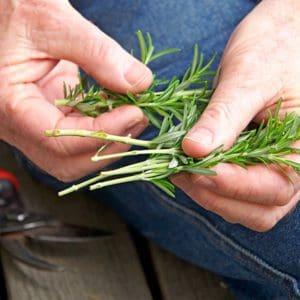
Rosemary is a staple in every herb garden. This hardy Mediterranean shrub is popular for a variety of purposes, including cooking, cosmetics, and herbal medicines. Learning how to propagate rosemary is easy.
For a lot of people, rosemary is one of those gorgeous nostalgic scents that belongs in a herb garden.
For those who live a self-sufficient lifestyle of homesteading, rosemary is a multi-purpose essential.
Rosemary is responsible for providing a good source of antioxidants, anti-inflammatory compounds, calcium, potassium, iron, and a variety of vitamins.
Plus, rosemary can be used to treat dry scalps, to promote hair growth, and can be used to relieve symptoms of anxiety and bad moods.
The main problem with rosemary is that it is notoriously difficult to grow from a seed. When you live a homestead lifestyle, you can’t exactly go to a local store to find a new rosemary plant.
Self-sufficiency is all about working with what you’ve got, which means you need to learn how to propagate rosemary.
Luckily for you, we’ve got you covered. Here is everything you need to know about how to propagate rosemary!
Benefits Of Propagating Rosemary
Not only is it far easier to grow rosemary from propagation than from a seed, but propagating rosemary is actually highly beneficial for the plant.
While rosemary is extremely hardy, it’s also a pretty fussy plant. If it’s not in the optimal conditions for growth, it won’t grow at all.
Taking cuttings from an already mature rosemary plant will significantly speed the process of growth, allowing you to use and harvest the new rosemary plant quickly.
Plus, if the plant is coming towards the end of its lifespan, taking cuttings is the best way to continue the life of the thriving plant by encouraging it to grow again!
How To Propagate Rosemary
Cuttings
The most common method of propagating rosemary is to take cuttings of a mature, healthy plant. There are two ways to complete propagation through cutting: in water or in soil.
Water
- Sterilize a pair of scissors or shears, ensuring no bacteria can be spread to the rosemary plant and the soon-to-be cutting.
- Make a cutting of 6-8” of the mother plant, ensuring to only cut the green or purple stem rather than the wood-like stem. This is because the softer stem contains all the nutrients and energy required for propagation.
- Ensuring that your hands are clean, remove the bottom half of the leaves of the cutting. It doesn’t matter how many leaves you remove as long as you only remove the ones that would otherwise be submerged in water, which brings us to the next step!
- Choose an appropriate glass jar for propagation! A small empty sauce jar will work just fine. Fill the glass with clean cold water and place the rosemary cutting inside the jar, ensuring that no leaves touch the water.
- Place the glass jar on a windowsill that gets a lot of access to sunlight. Rosemary thrives in warm temperatures and sunny weather, so the more sunlight, the better!
- Replace the water in the jar every 3 days and wait until you can see roots appear from the cutting.
- Prepare a pot or area in your herb garden with well-draining soil.
- Once the roots appear, plant the cutting into the well-draining soil, and care for it as you normally would. For the first month, make sure to keep the cutting extra hydrated until it is fully established, after which you can water it less frequently.
The reason the water method is often preferred by hobbyists and plant enthusiasts is that a clear, glass jar allows you to watch the roots grow.
Not only is this fascinating to watch, but it also gives you a clear indication of when the cutting is ready to be planted in soil.
Soil
- Take a cutting of the rosemary in the same way as the previous method, but you can opt for a cutting longer than 6-8” this time. Make sure your scissors or shears are sterilized!
- Prepare a potting mixture in a terracotta pot. To choose the size of the pot, aim for something that can accommodate 2-3 cuttings, but not something so big that the cuttings are overwhelmed by nutrients. The soil needs to be a well-draining soil, otherwise ordinary soil can lead to root rot, which will kill the cutting and infect the soil. We recommend mixing one part perlite with two parts multi-purpose compost to allow enough nutrients without drowning the cutting.
- Cut the original cutting into smaller cuttings. To do this, trim the original cutting from the bottom to where the first leaf node is, and discard this piece. Then, make as many 4-6” cuttings from the original cutting as you can.
- Make sure to not plant the cuttings upside down by keeping a note of where you made the cutting.
- Strip around 2-3” of leaves from the bottom of each cutting.
- This isn’t necessary, but to stimulate the growth of the cuttings, we recommend dipping the end of each cutting into rooting hormone powder. Then, plant the cuttings into the outer edge of the soil in the pot, leaving a gap of between 1.5-2” between each cutting. The reason they prefer to grow at the outer edge is because while cuttings need to be hydrated, rosemary generally prefers drier environments, so this will benefit the plant in the long-run and prevent the risk of root rot from overwatering.
- Give the cuttings a nice amount of water and allow it to drain properly.
- Make a mini, DIY greenhouse by covering the pot and cuttings in a plastic bag. It should remain in this bag for 4-8 weeks, as this is enough time for a root system to be established. During this time, make sure to keep the soil nice and moist.
- Once you notice roots coming out from the bottom of the pot, you can remove each cutting and put it in its own pot. Follow the same procedure with the plastic bag and hydration for another month.
- Once established, harden the rosemary plants by leaving them outdoors during warm and sunny days and bringing them back indoors at night. This process should take a week, and it works to prevent stress from the change of environment. Then, you can plant the rosemary wherever you like!
